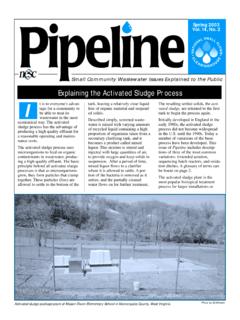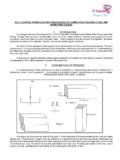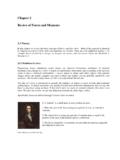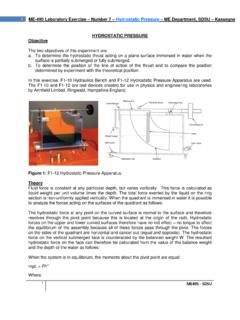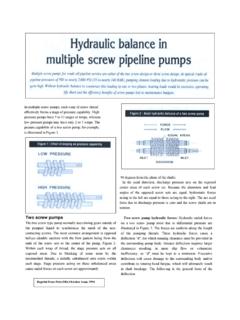Transcription of PUBLISHED BY THE NATIONAL ENVIRONMENTAL …
1 Why is understanding hydraulics important? The science of hydraulics is as old as civilization centuries, engineers have succeeded in making waterflow from one place to another with as few hitches aspossible. When problems do occur, they are usuallyrelated to the hydraulics involved in pipe flow. Liquids in motion produce forces and pressure wheneverthe velocity, flow direction, or elevation pipe pressure and flow at certain points alongthe pipe s path can help determine pipe size and capac-ity. It also can help in determining what pipe materialwould work best in given situations. Further, having anunderstanding of hydraulics can help system managersdecide if pressure reducers or pumps are necessary totransport water in an efficient manner.
2 Most small waterand wastewater systems do not have an engineer onstaff, or even one they can consult, who might be able toanswer simple or basic questions about hydraulics. Andthe cost of engineering advice can quickly add many small systems are on tight budgets,understanding hydraulics can save and Variables First of all, understanding that water has a unit weightis important. System designers need this information tocalculate other variables. The physical and hydraulicbehavior of wastewater is so similar to that of cleanwater that there is generally no difference in the designor analysis of systems involving these two liquids. Forpractical purposes, water and wastewater are consideredto be incompressible liquids because their volume doesnot change significantly with changing pressure .
3 Wateror wastewater has a unit weight of pounds perPUBLISHED BY THE NATIONAL ENVIRONMENTAL SERVICES CENTER fundamentals of Hydraulics: PressureSummaryHydraulics is the branch of engineering that focuses on the practical problems of collecting, storing, measuring,transporting, controlling, and using water and other liquids. This Tech Briefis the first of two that will discusssome fundamental hydraulic problems and will focus primarily on pressure . The second will discuss flow. By Zane Satterfield, P. E., NESC Engineering ScientistDownloadall of our Tech Briefsat foot ( lb/ft3); so, one cubic foot (1ft x 1ft x1ft) of water weighs lbs. There are gallons ina cubic foot, with each gallon weighing pounds, so gal x lbs/gal = the metric system, the term for weight (force dueto gravity) is called a Newton (N), and the unit weightof water is 9,800 Newtons per cubic meter (9,800N/m3).
4 More appropriately, this is expressed as per cubic meter ( kN/m3), where theprefix kilo stands for 1, important design information:One pound per square inch (lbs/in2or psi) is approx-imately equal to feet of water height (column ofwater) no matter how big around or square thecolumn is. One foot of water height is approximatelyequal to or wastewater exerts force and pressureagainst the walls of its container, whether it is storedin a tank or flowing in a pipe. But there is a differ-ence between force and pressure , although they areclosely related. Specifically, pressure is defined asforce per unit area. In units, pressure is usuallyexpressed in pounds per square inch (lb/in2or psi).
5 In SI metric units, pressure is expressed in Newtonsper square meter (N/m2). For convenience, the unitN/m2is called a Pascal (Pa). Since a pressure of 1 Pais a relatively small pressure (1 Pa = psi), theterm kilopascal (kPa) will be used in most practicalhydraulics applications. 1 kPa = 1000 Pa = this equation, pressure can be expressed as:P = F/AWhere P = pressureF = forceA = area over which the force is distributed PAGEOFFOURTT eecchh BBrriieeff fundamentals of Hydraulics: pressure , Winter 2010, Vol. 9, Issue 4 hydrostatic PressureThe pressure water exerts is called hydrostaticpressure. These principles always apply tohydrostatic pressure :1. pressure depends only on the depth ofwater above the point in question (not onthe water surface area).
6 2. pressure increases in direct proportion tothe depth of in a continuous volume of wateris the same at all points that are at thesame depth or pressure at any point in the water acts inall directions at the same the two tanks connected by a hori-zontal pipe shown in Figure 1. The water sur-faces in both tanks are at the same at the water s surface equals zero. pressure also exists at the free surfacebecause of the weight of air above. This pres-sure is called atmospheric or barometric pres-sure. Atmospheric pressure at sea level isapproximately psi or 101 kPa. In practi-cal applications, however, atmospheric pres-sure is not used for hydraulic calculations andis considered to be a zero reference or startingpoint.
7 This application is referred to as gaugepressure as opposed to absolute pressure . Figure 1 shows two storage tanks side by sidethat have different volumes but are the sameheight. Many water systems may have encoun-tered this circumstance when they need toupgrade and find that the older tank may belarger than the newer one. This figureexpresses that pressure at the same elevations from a larger diameter (more water storage) to asmaller diameter storage tank is still the same. Thepressure at point B near the bottom of the tank is greaterthan the pressure at point A. In application, if point Bwere exactly twice as deep as point A, the gauge pressureat point B would be exactly twice the pressure at point Abecause pressure varies in direct proportion to the , in Figure 1, consider point E in Tank 2.
8 Sincepoint E is at the same depth below the water surface aspoint A, the pressure at point E is the same as the pres-sure at point A. Note that it makes no difference thatTank 2 is narrower than Tank 1. hydrostatic pressuredepends only on the height of water above the points andnot on the volume or surface area of the water. Eventhough point C in the connecting pipe does not havewater directly above it, it still has the same pressure aspoints B and PressureIn customary U. S. units, 1 ft3of water weighs a 1-ft depth of water on an area of 1 ft2, or 144 in2,the pressure at the bottom would be P = lbs/144in2= psi per foot of water (lbs/in2)/ft). This is usu-ally written as:P = x hWhereP = hydrostatic pressure in psi (lbs/in2)h = water depth from surface in psi/ft or (lbs/in2)/ftIn SI-metric units, 1 m3of water weighs kN.
9 So a 1meter (m) depth of water on an area of 1 m2would havea pressure of kN/m2or usually written as can be written as:P = x hWhere P = hydrostatic pressure in kPa or kN/m2h = water depth from surface in meters (m) kPa or (kN/m2)/mExample 1A small water system has an elevated water storage tankand connecting ductile iron pipeline as shown in Figure typical situation for a small water system operator mightbe a recurrent leak at point D, the lowest the pipe with band clamps may no longer be anoption and replacing an entire joint or two of the pipe withsomething other than ductile iron is now the pressure at this point in the distributionsystem will aid in selecting pipe material, such as PVC,that is correctly classified and save money in the long run.
10 Calculate the hydrostatic pressures at points A, B, C,and For the above example, the diameter is known becausethe operator has worked on this pipe in the past. Usuallythe elevations can be obtained from as-built drawings ormaybe topographic maps with some measurements ofthe tank overflow for maximum water height. twoThe pressure at point A equals the pressure at point E, sincethese points are at the same depth in the water. Likewise, thehydrostatic pressure at points B, C, D are 1 Water SurfaceZero Gage PressureAETANK 1 TANK 2 Connecting PipeDCAandEBandCandDBDCBAEP oint A: The depth of water above point A in the tank isequal to the difference in elevation between the maximumwater surface and the tank bottom, or 2000 ft 1,950 ft= 50 ft.
